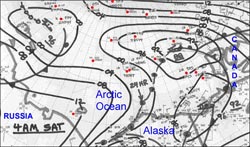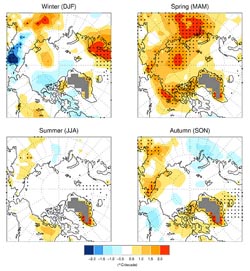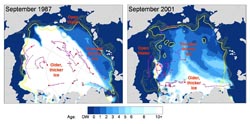 Figure 1. Weather forecast (click figure to enlarge)
Figure 1. Weather forecast (click figure to enlarge)  Figure 2. Change in ice drift (click figure to enlarge)
Figure 2. Change in ice drift (click figure to enlarge)  Figure 3. Arctic warming (click figure to enlarge)
Figure 3. Arctic warming (click figure to enlarge)  Figure 4. Change in age of sea ice (click figure to enlarge)
Figure 4. Change in age of sea ice (click figure to enlarge)  Figure 5. Buoy observations (click figure to enlarge)
Figure 5. Buoy observations (click figure to enlarge)
History
A network of automatic data buoys to monitor synoptic-scale fields of sea level pressure, surface air temperature, and ice motion throughout the Arctic Ocean was recommended by the U.S. National Academy of Sciences in 1974. Based on the Academy's recommendation, the Arctic Ocean Buoy Program was established by the Polar Science Center (PSC), Applied Physics Laboratory-University of Washington, in 1978 to support the Global Weather Experiment. Operations began in early 1979, and the program continued through 1990 under funding from various agencies. In 1991, the International Arctic Buoy Programme (IABP) succeeded the Arctic Ocean Buoy Program, but the basic objective remains - to maintain a network of drifting buoys on the Arctic Ocean to provide meteorological and oceanographic data for real-time operational requirements (e.g. Fig. 1) and research purposes including support to the World Climate Research Programme and the World Weather Watch Programme (e.g. Figs. 2-4).
This proposal is for the renewal of NSF funding of the United States Interagency Arctic Buoy Program (USIABP), which manages US contributions to the IABP. Funds from this proposal will be used for the coordination, and data management of the IABP. The tasks of coordination and data management of the IABP are detailed in the Operating Principles of the IABP. We also propose to purchase and deploy Ice Mass Balance and air drop buoys which monitor atmospheric and sea ice conditions to augment the IABP Arctic Observing Network.
The IABP evolved from a succession of buoy programs beginning with the Arctic Ocean Buoy Program of the PSC. These programs were initially funded by grants for basic research, but interest and support increased as the community recognized the operational value of the data (e.g. Fig. 1).
In 1990, the National Ice Center (NIC) was designated as the focal operational organization for U.S. buoys on the Arctic Ocean, with responsibility for the overall management and cooperation. The United States contribution to the IABP is coordinated through the United States Interagency Arctic Buoy Program (USIABP), which is managed by the National Ice Center (NIC) and the PSC. The USIABP is a collaborative program that draws operating funds and services from a number of U.S. government organizations and research programs. These organizations include the International Arctic Research Center at the University of Alaska Fairbanks, the National Aeronautics and Space Administration, the National Oceanic and Atmospheric Administration, the National Science Foundation, the Naval Oceanographic Office, the NIC, the Office of Naval Research, and the U.S. Coast Guard. (A list of these contributions is given in Table 1.) From these contributions the USIABP acquires and deploys buoys on the Arctic Ocean, and supports the Coordination and Data Management for the IABP by the PSC.
In 1991, meetings were held to organize the IABP. A set of Operating Principles were adopted and the IABP became an Action Group of the Drifting Buoy Cooperation Panel, under the World Meteorological Organization (WMO) and the Intergovernmental Oceanographic Commission.
Today, the IABP is composed of 20 different research and operational institutions from 9 different countries. The IABP is funded and managed by Participants of the program. Management of the IABP is the responsibility of the Executive Committee, and operation of the program was delegated to the Coordinator of the IABP, Ignatius Rigor. The primary contribution of the USIABP to the IABP is to support the coordination and data management of the IABP.
Uses of Observations from the IABP
Dramatic changes in Arctic climate have been noted during the past two decades. It should be noted that many of these changes were first observed and studied using data from the IABP, which is analyzed and made available to the community by the PSC. For example, IABP data were fundamental to Walsh et al. (1996) showing that atmospheric pressure has decreased (Fig. 2), Rigor et al. (2000) showing that air temperatures have increased (Fig. 3), and to Proshutinsky and Johnson (1997); Steele and Boyd, (1998); Kwok, (2000); and Rigor et al. (2002) showing that the clockwise circulation of sea ice and the ocean has weakened (e.g. Fig. 2). Data from the IABP has also been assimilated into the global temperature data sets (e.g. Jones et al., 1999). All of these results relied heavily on IABP data. And, as such, maintaining and enhancing the IABP has been identified as a priority for the Study of Environmental Arctic Change (SEARCH).
In addition to supporting these studies of climate change, the IABP observations are also essential for: Forcing, assimilation and validation of global weather and climate models. For example, the buoy data has been used to validate the Polar Ice Prediction System model developed at the Naval Research Laboratory, and are assimilated into the National Center for Environmental Prediction - National Center for Atmospheric Research reanalysis data sets (Kalnay et al. 1996).
Validation of satellite retrievals of environmental variables. For example, the buoy data are used to validate satellite estimates of sea ice motion (e.g. Lindsay and Stern, 2003), and surface temperatures (e.g. Comiso, 2003).
Forecasting weather. For example, in Fig. 2, we show a storm off the coast of Alaska whose strength and trajectory would have been difficult to predict without observations from the buoys.
Predicting sea ice conditions. Our ability to accurately forecast sea ice conditions depends on observations of surface air temperature and sea ice motion over the Arctic Ocean. For example, during the summers of 2002 and 2003, colder than normal air temperatures were observed over the Alaskan coast (e.g. Serreze et al. 2003), and yet record minima in sea ice extent were observed. In order to explain this paradox, Rigor and Wallace (2004) hypothesized that these recent minima may be due to changes in the thickness of sea ice blown towards the Alaskan coast by the surface winds. To show this, they used a simple model to estimate the age of sea ice based on the observed drift (residence time) of the sea ice provided by the buoys. They showed that the age (and thickness) of sea ice has decreased dramatically in the 1990's, and this younger, thinner sea ice was observed to drift towards the Alaskan coast during the last few years. They argued that although temperatures may have been colder, the air was still warmer than the melting temperature of sea ice, and it simply takes less heat to melt younger, thinner sea ice, thus explaining the recent record minimums in sea ice extent during the last 3 summers (Fig. 4).
